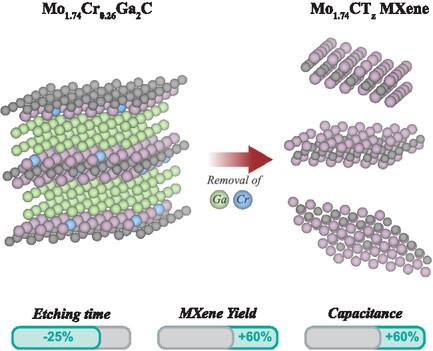Defect Engineering: Synthesis and Electrochemical Properties of Two-Dimensional Mo1.74CTz MXene
IF 11.1
Q1 MATERIALS SCIENCE, MULTIDISCIPLINARY
引用次数: 0
Abstract
The creation of vacancies and/or pores into two-dimensional materials, like graphene and MXenes, has shown to increase their performance for sustainable applications. However, a simple and affordable method with controlled and tailorable vacancy concentration and/or pores size remains challenging. Herein, a simple and reproducible method is presented for controlled synthesis of Mo1.74CTz MXene with randomly distributed vacancies and pores, obtained from selective etching of both Ga and Cr in the Cr-alloyed MAX-phase like precursor Mo1.74Cr0.26Ga2C. Structural and compositional analysis of the 3D alloy show ≈13% Cr on the metal site, homogeneously distributed between different particles and within the atomic structure. After etching, it translates to Mo1.74CTz MXene, exhibiting defect-rich sheets. Notably, the incorporation of Cr facilitates a shorter etching time with an improved yield compared to Mo2CTz. The Mo1.74CTz MXene displays excellent electrochemical properties, almost doubling the capacitance values (1152 F cm−3 and 297 F g−1 at 2 mV s−1 scan rate), compared to its pristine counterpart Mo2CTz. The presented method and obtained results suggest defect engineering of MXenes through precursor alloying as a pathway that can be generalized to other phases, to further improve their properties for various applications.

缺陷工程:二维 Mo1.74CTz MXene 的合成与电化学特性
在二维材料(如石墨烯和 MXenes)中制造空位和/或孔隙已被证明可提高其可持续应用的性能。然而,一种简单、经济、可控、可定制空位浓度和/或孔隙大小的方法仍然具有挑战性。本文介绍了一种简单且可重复的方法,用于控制合成具有随机分布空位和孔隙的 Mo1.74CTz MXene,该方法是通过选择性蚀刻铬合金 MAX 相类似前驱体 Mo1.74Cr0.26Ga2C 中的镓和铬而获得的。三维合金的结构和成分分析表明,金属位上的铬含量≈13%,均匀地分布在不同颗粒之间和原子结构内部。蚀刻后,它转化为 Mo1.74CTz MXene,呈现出缺陷丰富的薄片。值得注意的是,与 Mo2CTz 相比,铬的加入有助于缩短蚀刻时间,提高成品率。与原始的 Mo2CTz 相比,Mo1.74CTz MXene 显示出优异的电化学特性,电容值几乎翻了一番(2 mV s-1 扫描速率下分别为 1152 F cm-3 和 297 F g-1)。所介绍的方法和获得的结果表明,通过前驱体合金化实现 MXenes 的缺陷工程是一种可以推广到其他相的途径,从而进一步提高它们在各种应用中的性能。
本文章由计算机程序翻译,如有差异,请以英文原文为准。
求助全文
约1分钟内获得全文
求助全文
来源期刊
CiteScore
14.00
自引率
2.40%
发文量
0
期刊介绍:
Small Science is a premium multidisciplinary open access journal dedicated to publishing impactful research from all areas of nanoscience and nanotechnology. It features interdisciplinary original research and focused review articles on relevant topics. The journal covers design, characterization, mechanism, technology, and application of micro-/nanoscale structures and systems in various fields including physics, chemistry, materials science, engineering, environmental science, life science, biology, and medicine. It welcomes innovative interdisciplinary research and its readership includes professionals from academia and industry in fields such as chemistry, physics, materials science, biology, engineering, and environmental and analytical science. Small Science is indexed and abstracted in CAS, DOAJ, Clarivate Analytics, ProQuest Central, Publicly Available Content Database, Science Database, SCOPUS, and Web of Science.

 求助内容:
求助内容: 应助结果提醒方式:
应助结果提醒方式:


